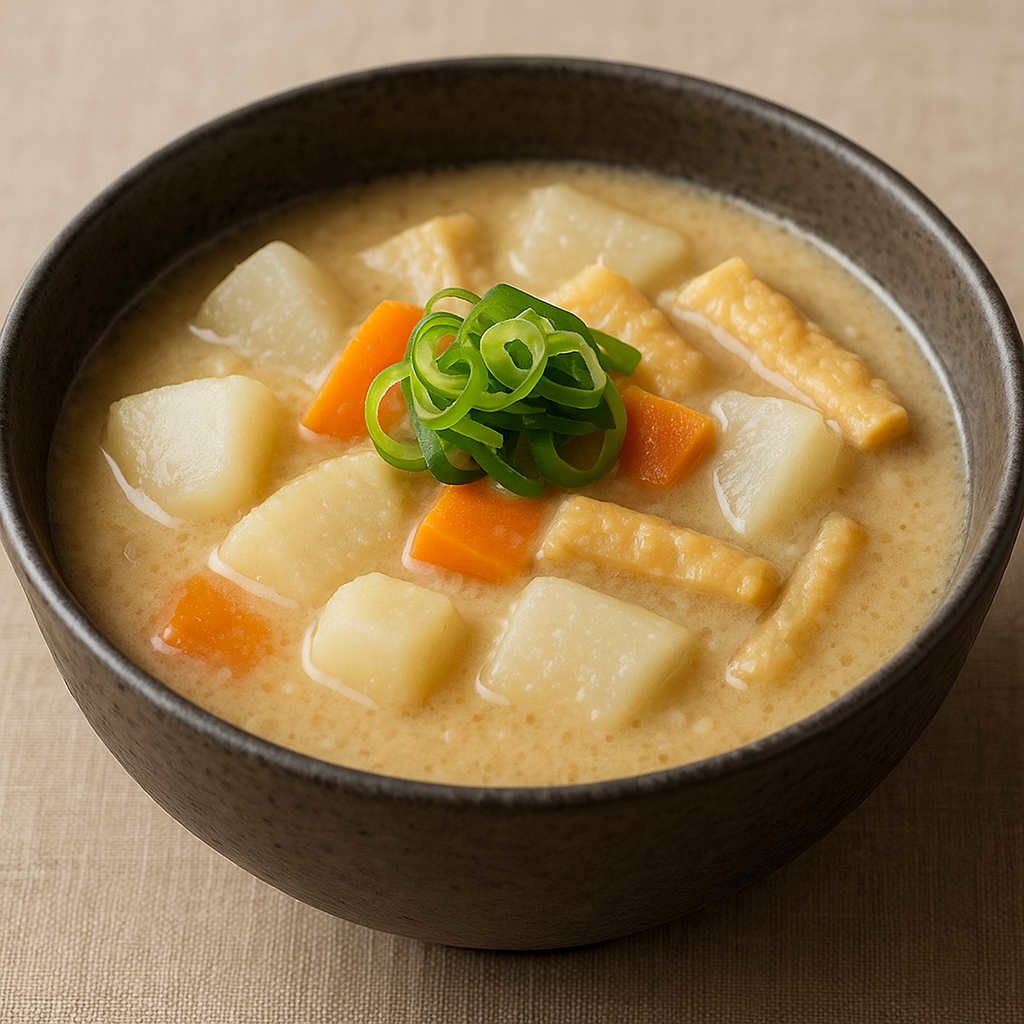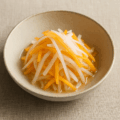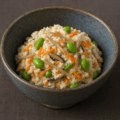呉汁(宮城)の特徴
すり潰した大豆「呉」でまろやか、たんぱく質たっぷり
宮城で親しまれる呉汁は、戻した大豆をすり潰した「呉(ご)」を加える味噌仕立ての汁物です。大豆の自然な甘みとコクで口当たりがまろやかになり、体がほっと温まります。
根菜・こんにゃく・油揚げで食べ応え十分
大根やにんじん、ごぼうにこんにゃく、油揚げを合わせると、香りとうま味の層が広がります。仕上げに仙台味噌を合わせると、深みのある味わいにまとまります。
呉汁(宮城) レシピ
材料
- 乾燥大豆 … 70g(またはゆで大豆 … 150g)
- 水(大豆浸水用) … たっぷり
- だし(昆布かつお) … 600ml
- 味噌(仙台味噌など) … 大さじ2.5〜3
- 大根(いちょう切り) … 100g
- にんじん(半月切り) … 50g
- こんにゃく … 1/2枚(100g)
- 油揚げ … 1/2枚
- 万能ねぎ … 適量(仕上げ用)
- 酒 … 大さじ1
- 下処理用:塩・熱湯 … 適量
作り方
- 乾燥大豆は洗い、一晩浸す。翌日、やわらかくなるまでゆで、湯を切る(ゆで大豆使用なら省略)。
- 大豆にだし少量を加え、ミキサーまたはすり鉢でなめらかにすり潰して「呉」を作る。
- 油揚げは熱湯をかけて油抜きし、短冊に切る。こんにゃくはちぎって下ゆでする。長ねぎは小口切りにする。
- 鍋にだしを入れ、大根・にんじん・こんにゃく・酒を加えて中火で煮る。アクを取る。
- 火を弱め、呉をだしでのばして鍋に加える。底が焦げないように混ぜながら、ふつふつ手前まで温める(強く煮立てない)。
- 味噌を溶き入れ、沸騰直前で火を止める。
- 味をととのえ、器に盛る。
シェフのワンポイントアドバイス
- 呉は細かくなめらかにするとザラつきが出にくく、口当たりが良くなります。
- 鍋底が焦げやすいので、呉を入れた後は弱火で絶えず底から混ぜると安心です。
- こんにゃくは下ゆですると臭みが抜け、味の入りが良くなります。
- 代用案:無調整豆乳を使う場合は、仕上げに加えて煮立たせずに止めると分離を防げます。
栄養価(1人分の目安)
- エネルギー … 約250kcal
- たんぱく質 … 約16g
- 脂質 … 約9g
- 炭水化物 … 約22g
- 食塩相当量 … 約2.3g
- 特徴成分 … 大豆由来のたんぱく質・食物繊維・カリウムを含みます
歴史
大豆を生かす郷土の知恵
収穫した大豆を無駄なく使う知恵から生まれ、東北各地で親しまれてきました。すり潰した大豆を汁に加えることで、栄養と満足感を高めます。
宮城の味噌文化との相性
仙台味噌の力強い香りと呉のまろやかさがよく合い、寒い季節の定番の一椀として受け継がれています。
「呉」の名の由来
水で戻した大豆をすり潰したものを「呉」と呼ぶことに由来し、地域や家庭で具材や濃度に個性が見られます。
English Version
Features of Gojiru (Miyagi)
Creamy miso soup enriched with ground soybeans (“go”)
Gojiru is a miso-based soup that blends in puréed soybeans called “go,” giving a naturally sweet, nutty depth and a smooth, comforting mouthfeel.
Hearty with roots, konnyaku, and abura-age
Daikon, carrot, konnyaku, and abura-age add aroma and body. Using Sendai miso brings a robust fragrance that pairs beautifully with the soybean richness.
Recipe – Gojiru (Miyagi)
Ingredients
- Dried soybeans … 70 g (or cooked soybeans … 150 g)
- Water for soaking … plenty
- Dashi (kombu–bonito) … 600 ml
- Miso (e.g., Sendai miso) … 2.5–3 Tbsp
- Daikon, half-moons … 100 g
- Carrot, half-moons … 50 g
- Konnyaku … 100 g
- Abura-age … 1/2 piece
- Scallions (to finish) … to taste
- Sake … 1 Tbsp
- For prepping: salt, boiling water … as needed
Directions
- Rinse dried soybeans and soak overnight; simmer until tender, then drain. (Skip if using cooked soybeans.)
- Make the “go”: purée the beans with a little dashi in a blender or mortar until smooth.
- Pour boiling water over abura-age to degrease and cut into strips. Tear konnyaku and parboil briefly. Slice scallions thin.
- Bring dashi to a gentle simmer; add daikon, carrot, konnyaku, and sake. Skim as needed and cook until tender.
- Lower the heat. Loosen the “go” with some hot broth and stir it into the pot, scraping the bottom to prevent sticking. Warm gently—do not boil hard.
- Dissolve in the miso and heat just below a boil.
- Taste, adjust seasoning, ladle into bowls, and finish with scallions.
Chef’s Tips
- Purée the soybeans very smooth for a silky texture with no graininess.
- After adding “go,” keep heat low and stir from the bottom to prevent scorching.
- Parboiling konnyaku removes odor and improves flavor absorption.
- Substitution: unsweetened soy milk can stand in—add at the end and avoid boiling to prevent separation.
Nutrition (per serving, approx.)
- Energy … ~250 kcal
- Protein … ~16 g
- Fat … ~9 g
- Carbohydrates … ~22 g
- Salt equivalent … ~2.3 g
- Notable nutrients … soybean protein, dietary fiber, potassium
History
Resourceful soybean cookery
Born from a desire to use the soybean harvest fully, gojiru has long been loved across Tōhoku—adding nourishment and satisfaction by blending beans into soup.
In harmony with Miyagi’s miso culture
Sendai miso’s bold aroma and the mellow body of “go” make a natural pairing, cementing the soup as a winter staple.
What “go” means
“Go” refers to soaked soybeans ground with liquid. Households vary the thickness and ingredients, giving the dish local personality.



何でも質問してください!